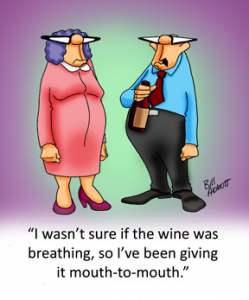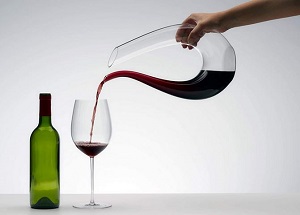Aerating wine can produce a significant and rapid improvement in a wine. Back in 2015, we watched a segment by ABC News’ Good Morning America making an inexpensive bottle ($7) of red wine to taste like a more expensive bottle of wine. We, the wine enthusiasts, have since hosted many “blind tests” of making a bargain bottle of wine taste more expensive by using various aerating methods. We have recently received several reader questions (inspired by the “artificial respiration” cartoon on our site) whether wine needs to breathe, here are our answers to “Is it necessary to aerate wine”?

- Despite what the cartoon characters think, letting wine breathe is not a form of artificial respiration!
- In 2015, ABC’s Good Morning America put a modestly priced wine through the blender for 30 seconds. Then they ran a blind test and the result showed the $7 bottle of wine after being aerated in the blender got as high a mark of approval of as an $87 bottle of wine.
What is wine aeration?
Wine aeration is the process of exposing the wine to air (oxygen) to remove or reduce certain compounds in the wine and to enhance others. It is a time-tested method of improving the bouquet and taste of many wines. Most people have heard of and perhaps used the simplest aeration technique, which is to simply open the wine a while before you drink it and let the wine “breathe” for a while before consuming it. Similarly, swirling wine in your glass is an aeration technique. There are also devices to more aggressively aerate wines.
Why aerate wines?
There are a number of good reasons to aerate wines. For example, there are certain compounds that may be in wines, such as sulfites, which have unpleasant aromas. Some of these aromatics can be reduced through the process of aeration. Also aeration can provide a better balance to a wine, allowing the more subtle flavors and aromas to emerge.

Aeration can make a significant improvement to a wine, often giving the characteristics of a more expensive wine to one that otherwise would seem unremarkable.
Which wines need to be aerated?
- Wine aeration works best for “big” complex red wines.
- Additionally, as shown in the ABC test (and our personal experience), aeration can significantly improve more moderately priced wines.
- In fact, older and more complex wines may benefit from more subtle forms of aeration, like decanting, whereas younger and less expensive wines may benefit most from more aggressive aeration.
How to aerate a wine?
Wine aeration may be accomplished several ways, although some are quicker and more effective than others.
- Simply uncork the bottle to allow it to “breathe” for a while prior to enjoying the wine (no rescue breathing required!)
- By decanting in a specially designed wine aerator decanter.
- By swirling in your wine glass (especially a specially designed aerating wine glass), and
- By using a specially designed wine aerator.
How much should I aerate?
Aeration of wine can be done “passively” such as by letting the wine breathe, decanting the wine, or simply swirling it in the glass. To speed the process, wine aerators can be battery-powered or CO2 powered (the latter can be fairly expensive to purchase and operate). It’s important to understand that introducing air into wine enhances the taste and nose in the short term, but does so by using the exact same mechanism of oxidation that causes wine to go bad over time. So if you aerate your wine, it should be for immediate consumption.
For mechanical aerators, the rule of thumb is that you should be able to see some bubbles that were introduced into your wine by the aerator when the wine goes into the glass. The bubbles will rapidly dissipate, but that shows that enough oxygen has been introduced into the wine.
What techniques and products are used to aerate a wine?
In addition to opening the wine to let it breathe in its own bottle, the market offers a variety of products to enhance the aeration process. Many of these are “funnels”, which may be powered to introduce air into the wine, through which you pour your wine into the glass and the aerator blends air in with the wine to produce the benefits of aeration. Here are the techniques and products to facilitate wine aeration:
- Decanter – A common and easy technique is to use a decanter as an aerator. Pouring wine into a decanter, or even back-and-forth between decanters, more rapidly exposes a greater surface area of the wine to the air. The action of pouring a wine into a decanter (or between decanters) mechanically introduces air into the wine to enhance oxidation and to allow strong aromatics to dissipate.
- Aerator or Vinturi – Vinturi wine aerators are a popular brand for wine aeration. The Vinturi brand is often used (improperly) as generic term for a wine aerator, and there are other brands (e.g., Wine Weaver). Typically aerators work either passively (wine is poured through complex funnel-like device which causes the wine to intermix with air) or actively (a mechanical device, perhaps battery powered, provides a blender-like intermixing of air with the wine).
- Aerating wine glasses – There are also Wine glasses with built-in aerator which increase aeration by the design of the glass or by 3-D designs on the surface of the glass.
Summary
So what is the conclusion? To Aerate or Not To Aerate? There is somewhat mixed evidence as to what degree aeration improves wine, but most tests suggest aeration does improve the taste and smoothness of wines and may make moderately priced wines taste like those wines with a significantly larger price tag. It is clear that the effects of aeration differ by the characteristics of the wine being aerated. It is well worth experimenting on your own using a decanter, an aerator or an aerating wine glass with wines you typically enjoy to evaluate the benefit of wine aeration personally.
As a final thought, can wine aeration reduce hangovers? The answer is: aerating wines may, in fact, reduce hangovers by reducing or eliminating compounds that may cause headaches. For example, sulfites used to preserve wines may cause headaches in a significant portion of the population. So wine aeration and filtration may help by reducing sulfites in wines.





